1928 - Christie Organs Start to Arrive
In March, 1928, "Everyone's" contained an interesting survey of the types of music being played by organists and orchestras in cinemas in Sydney:
WHAT DO PICTURE-GOERS WANT IN MUSIC?
What do Sydney cinema audiences really want in music? Is there a particular liking for any
type? Do picture show patrons give any indication whether they like jazz
or classical fittings to their film fare?
"Everyone's" musical critic fired this barrage of questions at the orchestra conductors of five of Sydney's leading motion picture houses. Eddie Horton, who has taken Leslie V. Harvey's place at the console of the Prince Edward organ, was also roped in.
ALBERT CAZABON, conductor of the Prince Edward orchestra: Patrons of the Prince Edward like the best we can give them. They have been sort of educated up to a pitch of high musical appreciation. For instance, take the score of "The Scarlet Letter", which we are now featuring. The overture is Mendelssohn's "Ruy Blas", one of the world's classics. That it is appreciated is reflected night after night by the splendid ovations. Then again for a recent film we rendered a series of Liszt's Hungarian Rhapsodies. They were also well received.
I think that other than straight jazz should be confined to vaudeville. Jazz is played at the
Prince Edward, but it is played straight.
Every classic performed by my orchestra, the remnants of the late State Conservatorium Orchestra, is a finished performance: every note is rehearsed; every passage is practised like a string quartet. When "Chang" comes to this theatre, bizarre, weird and barbaric music will be necessary. The best people come to the Prince Edward because they know they will get the best music. Indicating pigeon holes labelled exotic, rustic, broad, solemn, passionate, romantic, light tension, mysterious, light sentimental, pathetic, marches, light and heavy overtures, suites, selections, we must fit music to the film so that every phase of human nature is covered. I think the Prince Edward patrons prefer good music, and they appreciate it.
EDDIE HORTON, Master Organist: Well, it is hard to say. It all depends on the theatre. The
organist must try to please his audience. I think the public
like jazz and good music mixed. If an organist can't please,
he soon gets a polite note from the directors stating that his
services are no longer required. The public is always
seeking and can never be satisfied. If the music is good,
there is applause; if it is bad, the musician gets Hell.
WILL QUINTRELL, who has been associated with Sydney Tivoli for many years as conductor: Well, I suppose because I conduct the Tivoli orchestra you expect me to say the public like jazz. They do. But listen. When Tom Katz and his Saxophone Band had such a good run in Sydney, he featured classical music and favourite airs of twenty years ago. The audience rose from the chairs. "Lily of Laguna", made famous twenty years ago by Eugene Stratton, caused great excitement. A climax was reached with the performance of "Soldiers of the King". All this proves that there is no marked love for jazz. Although the "Doll Dance" was popular, it did not cause a sensation like Leslie Stuart's medley. At the present time, Bradford and Russo are presenting Grand Opera Favourites, and are getting away with it splendidly. But I suppose that 95 per cent of Tivoli patrons are tickled pink with jazz.
ABE GELHOR, Conductor of the Lyceum orchestra: That is a puzzler. The most popular numbers played by my orchestra are the pot pourris with song slides. People like something with a lilt and swing, but I sandwich the good stuff in between. Personally, I think audiences like mixed music.
STAN PORTER, who has been Conductor of the Haymarket Operatic Orchestra for ten years: I have always featured good music, and it goes well. It gets the band. our theatre is patronised by musicians because they know they will get something good in music. Of course, audiences like a little jazz. I spice it judiciously. Jazz is quite acceptable if it is played straight. Good music is the feature of the Haymarket, and our overtures are well applauded. No! I wouldn't say there is a marked favouritism for jazz - picture-going Sydney likes the classics.
JIMMY ELKINS, Conductor of the Lyceum Wintergarden Band: Picture-goers like jazz. Something light is always preferable. People go to the cinema to be entertained and to forget troubles. I find musical comedy very acceptable. [Everyone's, 7 March, 1928, p. 48]
At this time, with medium-sized Wurlitzers costing from £10,000 upwards, organs were beyond the reach of most of the smaller exhibitors, and it was in the main left to the two major circuits to install them, until the less expensive Christie organs arrived.
Regent Theatre, Sydney
Hoyt's had obviously been well satisfied with the seven-rank
organ in the 2000-seat De Luxe Theatre, Melbourne, where it
no doubt suited the older-style, more intimate auditorium,
which had originally been built in 1915. Hoyt's ordered a
similar instrument, only one rank larger, for their new Regent
Theatre, Sydney. This theatre seated 2200, but although it
might seem on paper that an eight-rank organ would repeat
the De Luxe instrument's success, the planners had not
allowed for the cavernous nature of the huge new-style
auditorium, with its great width, plush furnishings and lofty
ceiling. This instrument was not a success, and Roy
Devany, the American organist who opened it, played it
mainly, if not exclusively, in conjunction with Signor Kost's
much-acclaimed orchestra and for film accompaniments. It was never advertised, nor does it
appear ever to have been used for solo features. It was soon to be overshadowed by the 15-rank
organ at the Capitol Theatre, Sydney, which opened a month later, on 7 April, 1928.
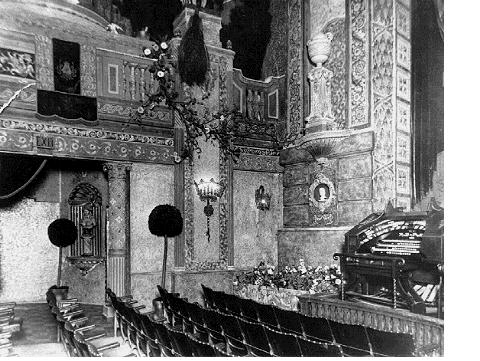 The Capitol Theatre, Sydney, was
Australia's first example of what
had become known in America as
the "atmospheric" style of
auditorium, intended to make
patrons feel as if they were out of
doors, with grottos, statuary and a
sky-like ceiling where stars
twinkled and clouds moved slowly
across. This style of theatre had
been popularised in America by the
architect John Eberson, and
contrasted strongly with the
traditional "hard top" school.
Atmospheric theatres were
considerably less costly to build
than their traditional counterparts,
and it was at the Paradise Theatre,
Faribault, Minnesota, that the
oft-quoted instruction to electricians was posted: "Please do not turn on the clouds until the show
starts. Be sure stars are turned off when leaving", words, which, as the late Ben Hall observed,
might well have come from the Book of Genesis. [Ben Hall, The Best Remaining Seats, Bramhall House, New
York, 1961]
The Capitol Theatre, Sydney, was
Australia's first example of what
had become known in America as
the "atmospheric" style of
auditorium, intended to make
patrons feel as if they were out of
doors, with grottos, statuary and a
sky-like ceiling where stars
twinkled and clouds moved slowly
across. This style of theatre had
been popularised in America by the
architect John Eberson, and
contrasted strongly with the
traditional "hard top" school.
Atmospheric theatres were
considerably less costly to build
than their traditional counterparts,
and it was at the Paradise Theatre,
Faribault, Minnesota, that the
oft-quoted instruction to electricians was posted: "Please do not turn on the clouds until the show
starts. Be sure stars are turned off when leaving", words, which, as the late Ben Hall observed,
might well have come from the Book of Genesis. [Ben Hall, The Best Remaining Seats, Bramhall House, New
York, 1961]
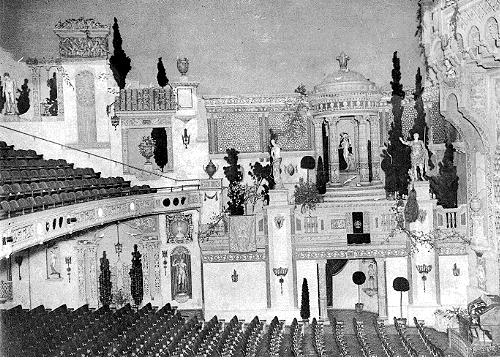
WHAT IS AN ATMOSPHERIC THEATRE?
"Imagine yourself seated in a beautiful, old world, Florentine garden. Above, the blue Mediterranean sky. Stars twinkle. Clouds float by as if in silent admiration of the beauty encased in those creeper-covered walls below.
"Rare statuary half-hidden in the twilight, adorns the alcoves and niches. Copies of famed pieces from the Vatican, the Louvre, the Museum of Santa Maria del Fiore, tell a story of elegance.
"Magnificent objects of art in beaten silver and gold and rich tapestries find a place in the gorgeous decorative scheme. White pigeons flutter to a resting place with love birds in the foliage of the cypress trees. Peacocks proudly display their brilliant plumage to the idler...
"Staggering in its immensity, enthralling in its magnificence, as you enter the mighty portals of this treasure house you will be amazed at the glory of the panorama that unfolds itself before you. Never before such supreme comfort, such splendour, such startling reality in construction, decoration and musical and motion picture entertainment." [Capitol Theatre, Sydney, pre-opening advertisement, 1928]
Fred Scholl introduced at the Capitol another novelty feature to Australian audiences:
"The third [unit was] three organ numbers by Frederick Scholl, the most popular of which was 'Ain't It a Grand and Glorious Feelin'?' illustrated by comedy slides. Certainly - words and everything. The house took to the idea; and one of these days Scholl is going to work a miracle with an Australian audience. Under the gentle persuasion of his organ they're going to join in and sing as cheerfully as they do in the best Broadway houses when these novelties appear." [Everyone's, 8 August, 1928]
On 29 June, 1928, Hoyt's opened another of their major Regents, this time the Regent Theatre, Adelaide. The organ ordered for this theatre was a twin to that in the Regent Theatre, Sydney, and would clearly be no more successful. It was never installed in Adelaide, and instead, a larger, fifteen-rank organ was ordered to take its place. As this instrument had only left the Wurlitzer factory in America a week before the theatre opened, it was September before Adelaideans were able to enjoy its rich tones.
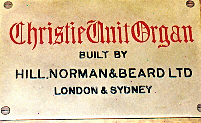 Until now, Wurlitzer had a monopoly on unit organ installations in
Australian theatres. However, things were changing, as in March, 1928,
Hill, Norman & Beard in England were constructing a two-manual
eight-rank organ in their London factory for the Regent Theatre, Perth.
[Hill, Norman & Beard, blueprints for organ for Regent Theatre, Perth, W.A.].
Until now, Wurlitzer had a monopoly on unit organ installations in
Australian theatres. However, things were changing, as in March, 1928,
Hill, Norman & Beard in England were constructing a two-manual
eight-rank organ in their London factory for the Regent Theatre, Perth.
[Hill, Norman & Beard, blueprints for organ for Regent Theatre, Perth, W.A.].
There is some mystery regarding this instrument's arrival in Australia, which would have occurred in the (Australian) winter of 1928. The Regent Theatre, Perth, opened in around August, 1928, having been rebuilt from the old Queen's Hall [Everyone's, 5 September, 1928]. In it was installed, but possibly not in time for the opening, as it was not mentioned in the trade press report) the two-manual eight-rank Wurlitzer originally scheduled for the Regent Theatre, Adelaide. Even at Perth, this instrument was too small, and was soon enlarged with four extra ranks. It would seem that the Christie was installed in the Regent Theatre, North Perth (later the Rosemount Theatre), for a short time in the winter of 1928 [Bell, Max, Perth, letter to IRM dated 30 October, 1975] , and was later that year ["Kinematograph Year Book", London, 1929 edition, lists the De Luxe Theatre, Melbourne, with 1928 Christie installations] moved to the De Luxe Theatre, Melbourne, where it replaced the Wurlitzer, which had meanwhile moved on to the Paramount Theatre, Melbourne.
The trade was soon in no doubt that a second builder was offering theatre organs. On 6 August, 1928, a full-page advertisement in the trade press proclaimed that a Christie organ had been ordered for the Lyceum Theatre, Sydney (where it was to replace the historic Fincham organ originally installed in the Exhibition Hall, Melbourne):
"The instrument when completed will be the most up to date unit installation in Australasia. No greater proof in necessary of the outstanding merits of THIS WONDERFUL BRITISH INSTRUMENT." [ Everyone's, 8 August, 1928]
The advertisement featured a photograph of the console of the Christie organ (3 manuals, 12 ranks) installed in the New Palace Cinema, Bristol, England, the largest Christie installation to date, but soon to be overshadowed by Christie's largest-ever cinema installation, at the Regal Theatre, Marble Arch, London (4 manuals, 37 ranks).
CHRISTIE UNIT ORGANS FOR SYDNEY THEATRES
When playing to a comedy subject, how many notes does the cinema organist exact from his instrument? It is estimated by the manufacturers of the Christie Unit Organ that the operator utilises over 60,000 notes per hour. To counteract this strain the Christie Unit is tested to over 600 repetitions per minute, which is a claim of no small importance.
Visitors to Australia have been surprised to discover that so few organs are installed in cinemas. It is pointed out that the installation of a modern unit orchestra organ is nowadays an absolute necessity, not a mere luxury, both for solo accompaniment to the pictures and also as a necessary addition to the small orchestra containing usually a piano and a few strings.
A unit organ in a theatre becomes at once a very powerful box office draw, especially if of the modern type possessing the clever effects and traps with which they are invariably provided, thus enabling the organist to make the picture live to a remarkable degree.
The days of the small orchestra are numbered, and if an exhibitor adheres to the old order he is only driving potential patrons to rival theatres equipped with more up-to-date and attractive music.
Of course, it is recognised that expense has to be considered, but the organ builder has come to the rescue of the proprietor of the small kinema and has designed a unit organ at a very low figure, but which will, nevertheless, enable him to give his patrons music practically as good as that provided at his richer rival's theatre.
The manufacturers of the Christie Unit Organ specialise in organs for small theatres as well as the large.
Effects embodied in the Christie Unit Organ include; thunder, sand block, cymbals, chimes, horse's hoofs, bird whistle, klaxon horn, syren, fire alarm, crowd cheering, wind howl, aeroplane, cannon effect, castanets, jingles, triangle, tubophone, police whistle, Chinese gong, punch on the nose, auto horn, sleigh bells, telephone bell, boat whistle, train whistle, slap in the face, rain, pistol shot, bang, drums, wood block and an applauding audience.
If a new cinema is being built and a Christie organ is to be installed, the type, size and arrangement and location of the instrument is discussed in consultation with the architect. When one is proposed to be fitted in an existing theatre, an expert is sent to study all the conditions governing the installation, which may necessitate some deviations from the normal in order to get the best results.
A Christie Unit Organ will be installed in the Lyceum Theatre, Sydney, in such a way that it can be used as a theatre organ and for services on Sunday, while another will go into the Victory Theatre, Kogarah. [ Everyone's, 8 August, 1928, p.34]
This advertisement shows the Regal, Theatre, Marble Arch, London, which contained Christie's largest unit theatre organ (4 manuals and 35 ranks of pipes)
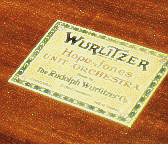
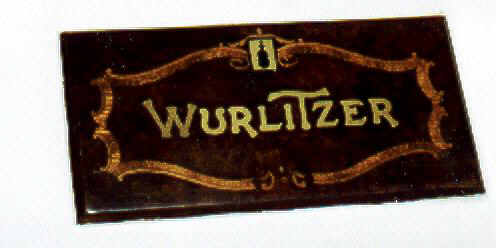
For the first time, Wurlitzer took a display advertisement in the same trade press, and on another
page of the same issue of "Everyone's" was a smaller panel with a curious drawing showing an organist seated on a piano stool playing an organ
console unlike any Wurlitzer had yet built (but with a
superficial resemblance to those built for Granada
Theatres in England from 1936 onwards) and
apparently pumping the swell pedals like a
harmonium. The perspective is distorted, for the
organist would have had to have arms of simian
proportions and very long legs to be able to play
seated on a stool well behind the pedalboard!
"That the leadership of the Wurlitzer ORGAN is an established fact is clearly perceived by its predominance in the finest theatres." [Everyone's, 8 August, 1928]
For the next two years or so the rival builders regularly advertised their instruments in "Everyone's", the Australian cinema trade journal.
In September, 1928, Eddie Horton, whose flag at that time was firmly nailed to the Wurlitzer mast, informed readers that the West Coast Circuit in America, for which he had previously been master organist "embraced over 110 theatres and 85 per cent of these theatres had Wurlitzer Unit Organs installed in them... the Wurlitzer organ lends itself in a far greater manner to the needs of the average organist..." [Everyone's, 12 September, 1928]
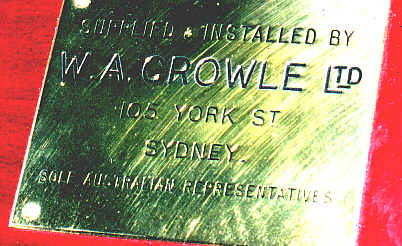
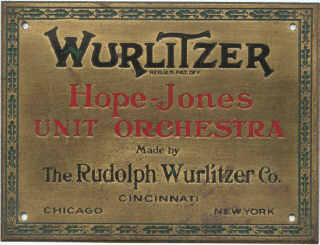
Australia was now in the midst of the greatest
boom in the building of super-cinemas it has
ever seen, or is likely to see. Yet another, the
atmospheric Ambassador's Theatre, Perth,
opened on 29 September, 1928, with Leslie
Waldron at the console of a fifteen-rank Wurlitzer.
Christie was hoping to cash in on this boom, but as yet only two of their instruments had come to Australia, the Perth organ mentioned above, and a seven-rank organ for the Victory Theatre, Kogarah, Sydney, which was opened in the latter half of 1928. Christie had just "missed the boat", as by now the organs for Union Theatres' and Hoyt's remaining programmes of capital city "supers" had most likely already been ordered - from Wurlitzer, the tried and trusted name.
However, the big circuits did not mean everything, and there were "pickings" to be sought from the smaller circuits and independent theatres, where the cheaper cost of the Christie product could prove a good selling-point:
"Christie Unit Organs, besides being made for the larger city cinemas, are also manufactured for provincial theatres. No matter how small the show in the country district there is a Christie Unit suitable. Christie Unit Organs are not graded in models, but are manufactured specially for the theatres for which they are ordered." [Everyone's, 12 December, 1928]
This point was aimed at Wurlitzer, which supplied only standard "stock" models to Australian theatres. There was also an appeal to patriotism:
"The firm may shortly commence to manufacture complete organ units in Australia. Already sectional work is carried out in Melbourne, and an extension of this business is more than probable during 1929." [Everyone's, 12 December, 1928]
In the same issue, Wurlitzer also directed its marketing at smaller theatres:
"This organ is as well suited to the small theatre as the large one. The instruments vary in size, of course, but many suburban theatres have proved that a Wurlitzer is easy to acquire, and is an excellent investment in returns." [Everyone's, 12 December, 1928]
So, with the big city contracts a foregone conclusion, the battle was now for the smaller theatre contracts.
There was one other contender in the lists, the Mustel Organ, marketed by Chappell & Co. Ltd. This was a reed organ, is essence a very sophisticated harmonium:
"There are Mustel models for every purpose; the Home - the Kinema - the Church - the Dance Hall. They range from exquisite instruments of small proportions to the larger models, which are orchestras in themselves." [Everyone's, 7 March, 1928 (Mustel Organ advertisement)]
MUSTEL ORGAN IDEAL FOR PICTURE THEATRES
"The importance of the Mustel Organ in a cinema orchestra can best be understood when its possibilities are realised.
"Under competent fingers it takes the place, up to a certain point, of reed and brass instruments, making possible the effects of sustained harmonies; it preserves a balance of tone, and is an excellent background for violin 'cello and other solos. It binds the various instruments into a compact whole, gives variety when used as solo, and a worksome relief from constant succession of instrumental solos, usually violin, cornet and flute." [Everyone's, 7 March, 1928, p.49]
Their target would have been the very small theatres, for solo use, and to augment theatre orchestras, a task for which they were highly suitable. No doubt, several of these instruments were installed in cinemas in Australia; there was one in the orchestra, played by Leon Foulon, at the Regent Theatre, Adelaide, when it opened, prior to the installation of the Wurlitzer. Several theatres in Queensland are known to have installed reed organs, which were not thrown out of tune by the climatic conditions in pre-airconditioning days.
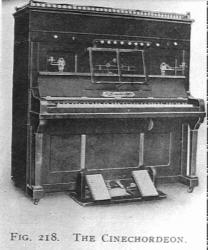
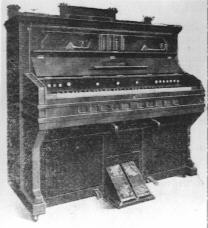
The "Cinechordeon" reed organ/piano combination and the "Cinphonium" reed organ, both designed for use in silent picture theatres